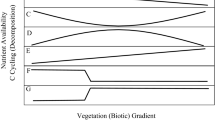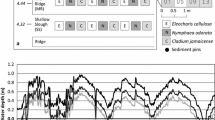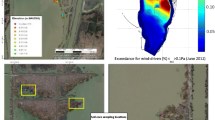Abstract
The development of wetland soil characteristics andbenthic invertebrate communities were evaluated increated Spartina alterniflorasalt marshes inNorth Carolina ranging in age from 1 to 25 years-old.A combination of measurements from different-agecreated marshes as well as periodic measurements overtime on two marshes were used to (1) document rates ofwetland pedogenesis, especially soil organic matter,and, (2) explore relationships between soil andbenthic invertebrate community development. Soilmacro-organic matter (MOM, the living and dead rootand rhizome mat), organic C and N increased and bulkdensity decreased during the 25 years following marshestablishment. The most dramatic changes in bulkdensity, MOM, C and N occurred within the upper 10 cmof the soil with lesser changes below this depth.Created marshes were sinks for organic C (90–140g·m-2·yr-1) and N (7–11g·m-2·yr-1) but not for P (0–1g·m-2·yr-1). The density of benthicinvertebrates (>250 μm) and subsurface-depositfeeding oligochaetes also increased over time oncreated salt marshes. Invertebrate and oligochaetedensity were strongly related to MOM content(r2= 0.83–0.87) and soil organic C(r2= 0.52–0.82) and N (r2= 0.62–0.84). Thesefindings suggest that, in created salt marshes,development of the benthic invertebrate community istied to marsh soil formation, especially accumulationof organic matter as MOM and soil. Field studies thatmanipulate the quantity and quality of soil organicmatter are needed to elucidate the relationshipbetween salt marsh pedogenesis and benthicinvertebrate community development.
Similar content being viewed by others
References
Adam, P. 1990. Salt marsh ecology. Cambridge University Press. Cambridge, England.
Alkemade, R., Wielemaker, A. and Hemminga, M.A. 1992. Stimulation of decomposition of Spartina anglica leaves by the bacterivorous marine nematode Diplolaimelloides bruciei (Monhysteridae). Journal of Experimental Marine Biology and Ecology 59: 267–278.
Bertness, M.D. 1985. Fiddler crab regulation of Spartina alterniflora production on a New England salt marsh. Ecology 66: 1042–1055.
Bijlsma, L., et al. 1996. Chapter 9: coastal zones and small islands. In: Watson, R.T., Zinyowera, M.C. and Moss, R.H. (eds.), Climate change 1995 - Impacts, Adaptations and Mitigation of Climate Change: Scientific-Technical Analysis. Contribution of working group II to the second assessment report of the intergovernmental panel on climate change. pp. 289–324. Cambridge University Press, New York. Author Query: need complete list of authors.
Broome, S.W., Craft, C.B. and Toomey, W.A., Jr. In press. Soil organic matter effects on infaunal community structure in restored and created tidal marshes. In: Weinstein, M.P. and Kreeger, D.A. (eds.), Concepts and Controversies in TidalMarsh Ecology. Kluwer Academic Publishers, Dordrecht, The Netherlands.
Broome, S.W., Seneca, E.D. and Woodhouse, W.W., Jr. 1988. Tidal salt marsh restoration. Aquatic Botany 32: 1–22.
Broome, S.W., Seneca, E.D. and Woodhouse, W.W., Jr. 1986. Longterm growth and development of transplants of the salt-marsh grass Spartina alterniflora. Estuaries 9: 63–74.
Broome, S.W., Woodhouse, W.W., Jr. and Seneca, E.D. 1975. The relationship of mineral nutrients to growth of Spartina alterniflora in North Carolina: II. The effects of N, P and Fe fertilizers. Soil Science Society of America Proceedings 39: 301–307.
Buol, S.W., Hole, F.D. and McCracken, R.J. 1989. Soil genesis and classification. Iowa State University Press, Ames, Iowa.
Cammen, L.M. 1976. Abundance and production of macroinvertebrates from natural and artificially established salt marshes in North Carolina. American Midland Naturalist 96: 487–493.
Costanza, R., d'Arge, R., de Groot, R., Farber, S., Grasso, M., Hannon, B., Limburg, K., Naeem, S., O'Neill, R.V., Paruelo, J., Raskin, R.G., Sutton, P. and van den Belt, M. 1997. The value of the world's ecosystem services and natural capital. Nature 387: 253–260.
Craft, C.B. 1999. Biology of wetland soils. In: Richardson, J.L. and Vepraskas, M.J. (eds.),Wetland Soils: Their Genesis, Hydrology, Landscapes and Separation into Hydric and Nonhydric Soils. Ann Arbor Press, Chelsea, Michigan. In press.
Craft, C.B. and Reader, J.M. 1997. Restored salt marshes: evolution of wetland structure and function over time. Final report to NOAA, National Estuarine Research Reserve System. November 30, 1997. 86 pp.
Craft, C.B., Seneca, E.D. and Broome, S.W. 1988. Nitrogen, phosphorus and organic carbon pools in natural and transplanted marsh soils. Estuaries 11: 272–280.
Craft, C.B., Seneca, E.D. and Broome, S.W. 1991. Loss on ignition and Kjeldahl digestion for estimating organic carbon and total nitrogen in estuarine marsh soils: calibration with dry combustion. Estuaries 14: 175–179.
Craft, C.B., Seneca, E.D. and Broome, S.W. 1993. Vertical accretion in microtidal regularly and irregularly flooded estuarine marshes. Estuarine, Coastal and Shelf Science 37: 371–386.
Craft, C.B., Reader, J.M. Sacco, J.N. and Broome, S.W. 1999. Twenty five years of ecosystem development of constructed Spartina alterniflora (Loisel) marshes. Ecological Applications. In press.
DeLaune, R.D., Baumann, R.H. and Gosselink, J.G. 1983. Relationships among vertical accretion, coastal submergence, and erosion in a Louisiana Gulf Coast marsh. Journal of Sedimentary Petrology 53: 147–157.
DeLaune, R.D., Reddy, C.N. and Patrick, W.H., Jr. 1981. Accumulation of plant nutrients and heavy metals through sedimentation processes and accretion in a Louisiana salt marsh. Estuaries 4: 328–334.
Frey, R.W. and Basan, P.B. 1978. Coastal salt marshes. In: Davis, R.A. (ed.), Coastal Sedimentary Environments. pp. 101–168. Springer-Verlag, New York.
Gallagher, J.L. 1974. Sampling macro-organic matter profiles in salt marsh plant root zones. Soil Science Society of America Proceedings 38: 154–155.
Gallagher, J.L. and Plumley, F.G. 1979. Underground biomass profiles and productivity in Atlantic coastal marshes. American Journal of Botany 66: 156–161.
Gambrell, R.P. and Patrick, W.H., Jr. 1978. Chemical and microbiological properties of anaerobic soils and sediments. In: Hook, D.D. and Crawford, R.M.M. (eds.), Plant Life in Anaerobic Environments. pp. 375–423. Ann Arbor Scientific Publications Inc., Ann Arbor, Michigan.
Gosselink, J.G. and R.E. Turner, R.E. 1978. The role of hydrology in freshwater wetland ecosystems. In: Good, R.E., Whigham, D.F. and Simpson, R.L. (eds.), Freshwater Wetlands: Ecological Processes and Management Potential. pp. 63–78. Academic Press, New York.
Greenwood, D.J. 1961. The effect of oxygen concentration on the decomposition of organic materials in soil. Plant and Soil 14: 360–376.
Hatton, R.S., Patrick, W.H., Jr. and DeLaune, R.D. 1982. Sedimentation, nutrient accumulation and early diagenesis in Louisiana Barataria Basin coastal marshes. In: Kennedy, V.S. (ed.), Estuarine Comparisons. pp. 255–267. Academic Press, New York.
Havens, K.J., Varnell, L.M. and Bradshaw, J.G. 1995 An assessment of ecological conditions in a constructed tidal marsh and two natural reference tidal marshes in coastal Virginia. Ecological Engineering 4: 117–141.
Kneib, R.T. 1984. Patterns of invertebrate distribution and abundance in the intertidal salt marsh: causes and questions. Estuaries 7: 392–412.
Kuo, S. 1996. Phosphorus. In: Methods of soil analysis. Part 3. Chemical methods. SSSA book series no. 5. pp. 869–919. Soil Science Society of America Inc. Madison, WI.
Lana, P.C. and Guiss C. 1992. Macrofauna-plant biomass interactions in a euhaline salt marsh in Paranagua Bay (SE Brazil). Marine Ecology Progress Series 80: 57–64.
Langis, R., Zalejko, M. and Zedler, J.B. 1991. Nitrogen assessments in a constructed and a natural salt marsh of San Diego Bay. Ecological Applications 1: 40–51.
LaSalle, M.W., Landin, M.C. and Sims, J.G. 1991. Evaluation of the flora and fauna of a Spartina alterniflora marsh established on dredged material in Winyah Bay, South Carolina. Wetlands 11: 191–208.
Lee, C. 1992. Controls on organic carbon preservation: the use of stratified water bodies to compare intrinsic rates of decomposition in oxic and anoxic systems. Geochimica et Cosmochimica Acta 56: 3323–3335.
Levin, L.A. and Talley, T.S. In press. Influences of vegetation and abiotic environmental factors in salt marsh benthos. In: Weinstein, M.P. and Kreeger, D.A. (eds.), Concepts and Controversies in Tidal Marsh Ecology. Kluwer Academic Publishers, Amsterdam, The Netherlands.
Levin, L.A., Talley, T.S. and Hewitt, J. 1998. Macrobenthos of Spartina foliosa (Pacific Cordgrass) salt marshes in southern California: Community structure and comparison to a Pacific mudflat and a Spartina alterniflora (Atlantic Smooth Cordgrass) marsh. Estuaries 21: 129–144.
Levin, L.A., Talley, D. and Thayer, G.W. 1996. Succession of macrobenthos in a created salt marsh. Marine Ecology Progress Series 141: 67–82.
Lindau, C.W. and Hossner, L.R. 1981. Substrate characterization of an experimental marsh and three natural marshes. Soil Science Society of America Proceedings 45: 1171–1176.
Lopez, G.R. and Levinton, J.S. 1987. Ecology of deposit feeding animals in marine environments. The Quarterly Review of Biology 62: 235–260.
Marinucci, A.C. 1982. Trophic importance of Spartina alterniflora production and decomposition to the marsh-estuarine system. Biological Conservation 22: 35–58.
Marsh, A.G. and Tenore, K.R. 1990. The role of nutrition in regulating the population dynamics of opportunistic surface deposit feeders in a mesohaline community. Limnology and Oceanography 35: 710–724.
Minello, T.J. and Zimmerman, R.J. 1992. Utilization of natural transplanted Texas salt marshes by fish and decapod crustaceans. Marine Ecology Progress Series 90: 273–285.
Minello, T.J., Zimmerman, R.J. and Medina, R. 1994. The importance of edge for natant macrofauna in a created salt marsh. Wetlands 14: 184–198.
Mitsch, W.J. and Gosselink, J.G. 1993. Wetlands. Van Nostrand Reinhold, New York.
Moy, L.D. and Levin, L.A. 1991. Are Spartina marshes a replaceable resource? A functional approach to evaluation of marsh creation efforts. Estuaries 14: 1–16.
Nyman, J.A., DeLaune, R.D., Roberts, H.H. and Patrick, W.H., Jr. 1993. Relationship between vegetation and soil formation in a rapidly submerging coastal marsh. Marine Ecology Progress Series 96: 269–279.
Osgood, D.T. and Zieman, J.C. 1993. Factors controlling aboveground Spartina alterniflora (smooth cordgrass) tissue element composition and production in different-age barrier island marshes. Estuaries 16: 815–826.
Poach, M.E. and Faulkner, S.P. 1998. Soil phosphorus characteristics of created and natural wetlands in the Atchafalaya Delta, LA. Estuarine, Coastal and Shelf Science 46: 195–203.
Ponnamperuma, F.N. 1972. The chemistry of submerged soils. Advances in Agronomy 24: 29–96.
Posey, M., T. Alphin and Powell, C. 1997. Plant and infaunal communities associated with a created marsh. Estuaries 20: 42–47.
Race, M.S. and Christie, D.R. 1982. Coastal zone development: mitigation, marsh creation and decision making. Environmental Management 6: 317–328.
Rader, D.N. 1984. Salt marsh benthic invertebrates: small-scale patterns of distribution and abundance. Estuaries 7: 413–420.
Redfield, A.C. 1972. Development of a New England salt marsh. Ecological Monographs 42: 201–237.
Sacco, J.N, Seneca, E.D. and Wentworth, T. 1994. Infaunal community development of artificially established salt marshes in North Carolina. Estuaries 17: 489–500.
Sarda, R., Foreman, K. and Valiela, I. 1995 Macroinfauna of a southern New England salt marsh: seasonal dynamics and production. Marine Biology 121: 431–445.
Scatolini, S.R. and Zedler, J.B. 1996. Epibenthic invertebrates of natural and constructed salt marshes of San Diego Bay. Wetlands 16: 24–37.
Schlesinger, W.H. 1991. Biogeochemistry: an analysis of global change. Academic Press, New York.
Seneca, E.D. and Broome, S.W. 1992. Restoring tidal marshes in North Carolina and France. In: Thayer, W.G. (ed.), Restoring the Nation's Marine Environment. pp. 53–78. Maryland Sea Grant College, College Park, Maryland.
Smith, K.K., Good, R.E. and Good, N.F. 1979. Production dynamics for above and belowground components of a New Jersey Spartina alterniflora tidal marsh. Estuarine and Coastal Marine Science 9: 189–201.
Sullivan, M.J. and Daiber, F.C. 1974. Response in production of cordgrass, Spartina alterniflora, to inorganic nitrogen and phosphorus fertilizer. Chesapeake Science 15: 121–123.
Valiela, I and Teal, J.M. 1975. Nutrient limitation in salt marsh vegetation. In: Reimold, R.J. and Queen, W.H. (eds.), Ecology of Halophytes. pp. 547–563. Academic Press, New York.
Valiela, I., Teal, J.M. and N.Y. Persson. 1976. Production and dynamics of experimentally enriched salt marsh vegetation: belowground biomass. Limnology and Oceanography 21: 245–252.
Warren, R.S. and Niering, W.A. 1993. Vegetation change on a northeast tidal marsh: interaction of sea-level rise and marsh accretion. Ecology 74: 96–103.
Zedler, J.B. 1992. Restoring cordgrass marshes in southern California. In: Thayer, G.W. (ed.), Restoring the Nation's Marine Environment. pp. 7–52. Maryland Sea Grant College, College Park, Maryland.
Author information
Authors and Affiliations
Rights and permissions
About this article
Cite this article
Craft, C. Co-development of wetland soils and benthic invertebrate communities following salt marsh creation. Wetlands Ecology and Management 8, 197–207 (2000). https://doi.org/10.1023/A:1008448620605
Issue Date:
DOI: https://doi.org/10.1023/A:1008448620605




